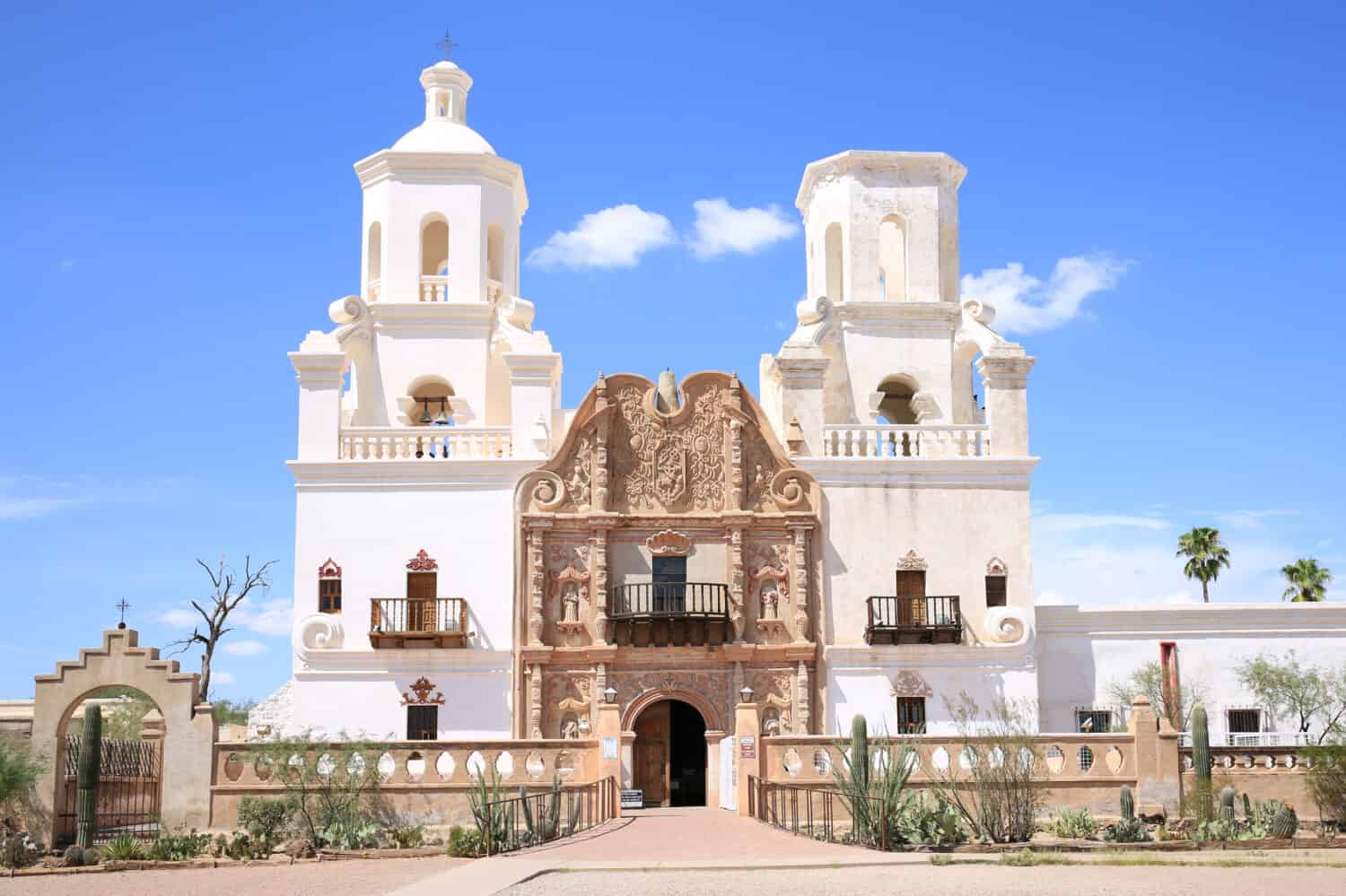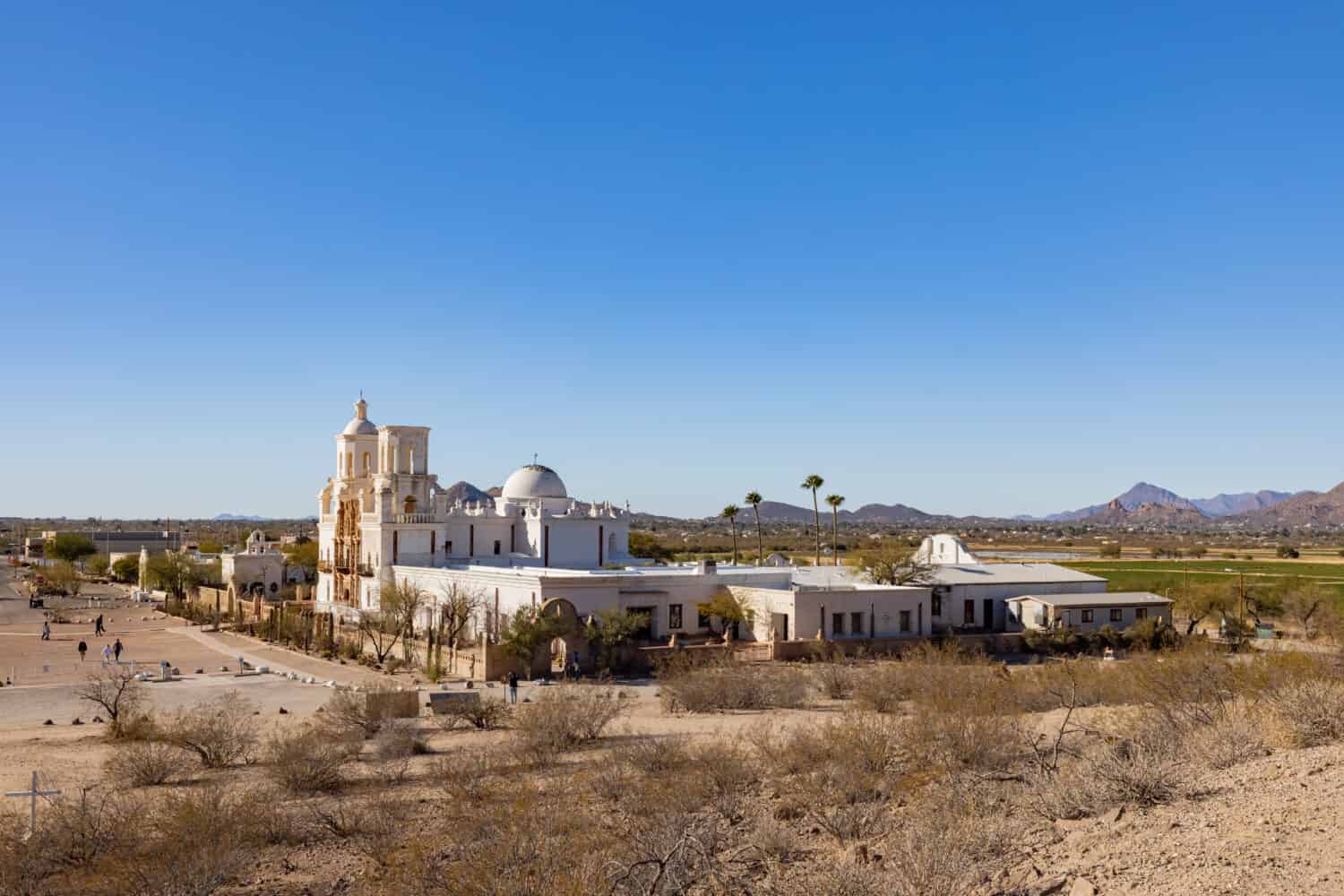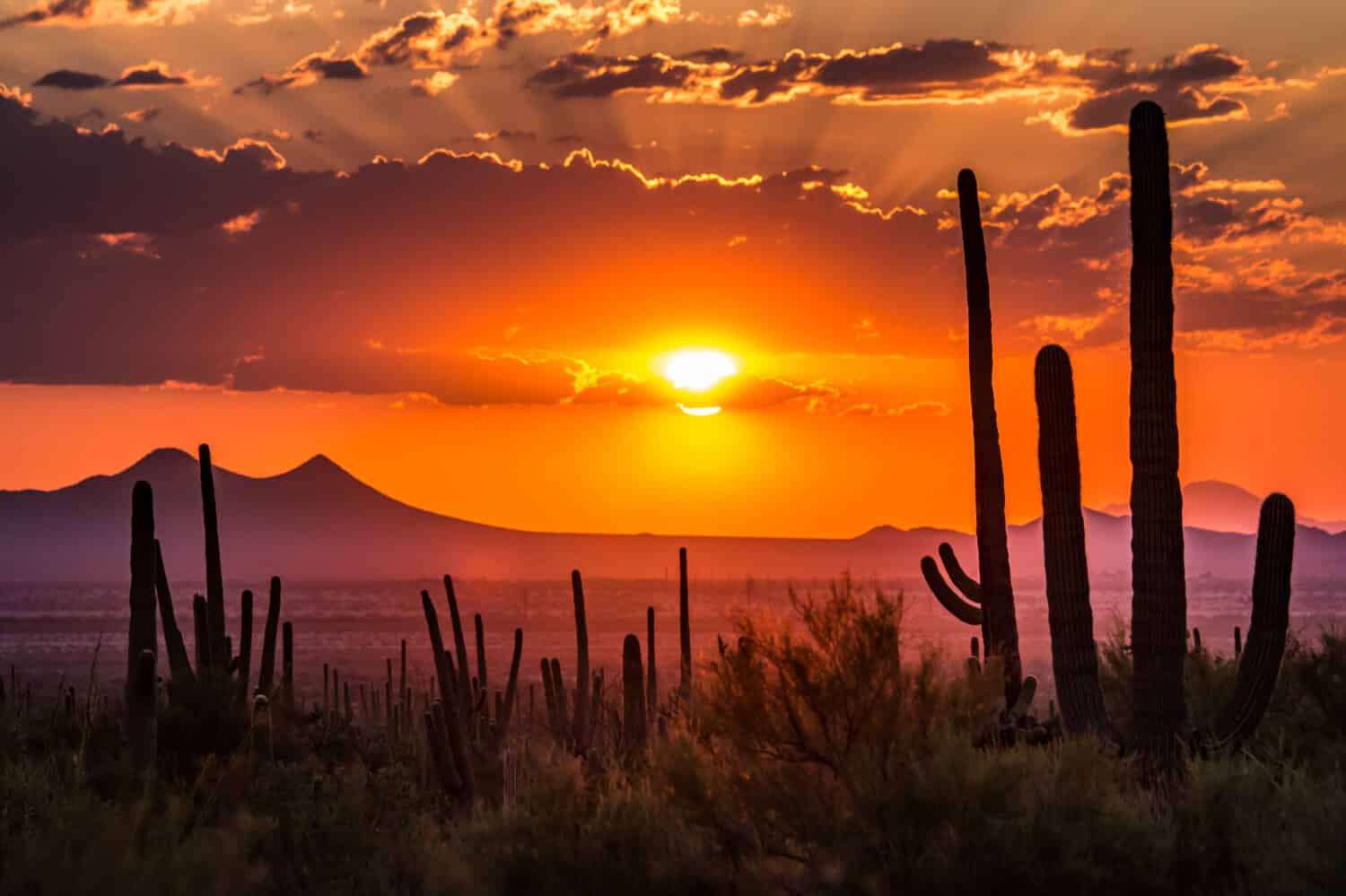
Arizona was part of Spanish and Mexican territories until 1848 when it was ceded to the United States as part of New Mexico. Arizona became a state in 1912. However, Arizona’s oldest habitable structure was built more than a century before the Grand Canyon territory would become a state.
San Xavier del Bac is the oldest European structure in Arizona. This stunning church was built in the late 18th century by Spanish Franciscans and O’odham Indians, and it still serves as a parish and a school for the local community. In this article, we will explore some of the fascinating aspects of this historic landmark.
The Origins of the San Xavier Del BAC
The San Xavier del Bac is a Catholic mission near Tucson, Arizona. But how did this Mission come to be? What were the historical and cultural factors that shaped its development?

San Xavier del Bac is an iconic mission that stands as a reminder of the fascinating history and culture of the Southwest.
©Traveller70/Shutterstock.com
The Sobaipuri O’odham
Before the arrival of the Europeans, the area where the Mission stands today was inhabited by the Sobaipuri O’odham. The Sobaipuri O’odham are indigenous people living in North America’s southwestern region. They’re part of the larger O’odham or Pima group, including the Tohono O’odham and the Akimel O’odham. The Sobaipuri O’odham has a long and rich history that spans from the prehistoric to the historic period.
Father Kino and the First Jesuit Missionaries
The first European to visit the Sobaipuri O’odham was Father Eusebio Francisco Kino, a Jesuit missionary from Italy. He arrived in 1692 as part of his efforts to establish a chain of missions in the Sonoran Desert.
Father Kino’s mission field was expansive, encompassing most of the western portions of Southern Arizona and northern Sonora that we recognize today. He made short visits to San Xavier, and in 1700, he spent a few days there to supervise the laying of foundations for a proposed grand church. Unfortunately, that dream never came to fulfillment. The area remained without a church or resident missionary when Kino passed on in 1711.
Construction of the First Church at San Xavier
The Jesuits appeared at San Xavier sporadically starting in 1732, yet the original church wasn’t constructed until 1756. Father Alonso Espinosa, S.J. oversaw its construction. It was a rectangular, flat-roofed mud adobe and mortar building. Although the church remains with a similar exterior design, it’s now situated in a different spot. The Mission’s east wing is attached to the current church’s east bell tower.
The arrival of the Franciscan Missionaries
In 1767, the Spanish King expelled the Jesuits from New Spain (Mexico), and in the subsequent year, the Franciscans replaced them in the northern Sonoran Desert missions. Father Francisco Garcés became the first Franciscan missionary at San Xavier del Bac.
Construction of the Present Church
In 1783, a Basque Franciscan, Father Juan Bautista Velderrain, began constructing the present church at San Xavier. Using wheat crops as collateral, he borrowed money from a local rancher to hire Ignacio Gaona, an architect from Mexico, and a large O’odham workforce. This resulted in one of the US’s most notable Mexican baroque structural design illustrations.
Father Velderrain passed on in 1790, and Father Juan Bautista Llorens succeeded him. Father Llorens supervised the church’s interior decoration. An anonymous painter and sculptor arrived from Mexico, and numerous religious statues were imported from Mexican guild workshops. Work halted in 1797 due to insufficient funds and the Mission’s creditor’s complaints, including the unfinished east bell tower. The church opened for services despite the unfinished work.
Mission San Xavier in the 19th century
Mission San Xavier was a part of New Spain before it was integrated into the Republic of Mexico in 1821. There was no material assistance from Mexico for the missions. By 1837, the last resident missionary of San Xavier in the 19th century had left.
In 1843, Franciscan management of all regional missions concluded, and the secular clergy took over responsibility for the churches. A circuit-riding Mexican priest would visit San Xavier only once a year until the Mission became part of the US in June 1854.
The Mission in the Diocese of Santa Fe
In 1859, the Diocese of Santa Fe added San Xavier to its territory. The Bishop of Santa Fe then attempted to assign clergy to Tucson and San Xavier with little success. Tucson became an incipient diocese (vicariate apostolic) in 1866. The local vicar apostolic subsequently dispatched secular clergy living in Tucson to the Mission for regular visits and to conduct services.
While residing there, the Sisters of St. Joseph of Carondelet set up a school at San Xavier in 1872. Today, the Mission’s school is run by the Franciscan Sisters of Christian Charity from Manitowoc, Wisconsin.
The School and Church Today
The Mission, established in 1692, still serves the O’odham’s descendants today. The church and school are essential to the community’s spiritual, educational, and social life.
It was designated a National Historic Landmark in 1960 and listed on the National Register of Historic Places in 1966. It underwent several restoration projects to preserve its structural integrity and artistic beauty,
11 Facts about the San Xavier Del BAC
1. It’s an Outstanding Example of Spanish Colonial Architecture
The Mission is considered one of the finest examples of Spanish Colonial architecture in the United States. It blends Moorish, Byzantine, and Baroque styles, with elaborate carvings, paintings, and sculptures. It has a symmetrical facade with two bell towers and a central dome. The exterior is covered with white plaster.
The church also has a baptistery, a sacristy, a choir loft, and a mortuary chapel. The mortuary chapel houses the remains of some early missionaries and settlers who died at the Mission.

The stunning beauty of San Xavier del Bac, also known as ‘the White Dove of the Desert.
©Kit Leong/Shutterstock.com
2. It Has a Unique Floor Plan
The Mission’s distinctive floor plan differs from most other Spanish missions. It has a cruciform shape.
3. The East Tower Remains Incomplete
The entire church is unfinished, with sketches of murals visible on the interior walls but left unpainted. Various legends have emerged over the years to explain why the tower was never completed, but none have any factual basis. Some of these tales include:
- A worker falling off the tower
- The owners are trying to avoid taxes by leaving the building incomplete
- A cyclone destroyed the dome on the east tower
4. It Has a Remarkable Collection of Art
The Mission is home to a remarkable collection of art that reflects its history and culture. The art includes paintings by European and Mexican artists, such as Ignacio Garcia, sculptures, and murals. The art depicts various religious scenes and symbols.
5. A Lightning Strike Wrecked a Minitower
The incident happened in 1939 and hit the 18th-century lantern on the west tower. The lantern was reconstructed with regular brick and mortar. In 2007, the minitower was reconstructed again. This time, however, threaded fiberglass rods were used to reinforce its legs instead of metal rods. This was done to prevent lightning from striking again.
6. It Was Unharmed By Tornadoes
On August 27, 1964, a fatal tornado hit the state and destroyed four homes in an Indian village. The tornado caused the death of two family members and injured eight.
Another tornado occurred on June 23, 1974, which lasted for about three minutes and caused the destruction of 19 mobile homes near the San Xavier Mission. One person was killed, and 40 people were injured.
7. It has no Mummy
Numerous visitors who enter the church observe the reclining figure in the glass enclosure located in the west transept and incorrectly assume it to be a type of mummy. However, it’s a sculpture of the crucified Christ, which was initially located at Tumacacori Mission, which is presently part of Tumacacori National Historical Park en route to Nogales.
In 1849, the community had to leave due to the raiding of the Apache. They carried their saints to San Xavier. The Statue of Christ was damaged during the journey and lost its legs. In the 1890s, it was showcased in the west transept as the Christ being entombed.
During the first World War, the statue was transformed into a reclining St. Francis Xavier. It was put in a glass case where it still receives a great deal of popular devotion.
8. It Is Still an Active Parish Church
The Mission is a historic site and an active parish church serving the Tohono O’odham community and other Catholics in the area. The Mission offers its members daily masses, sacraments, and pastoral care. It also hosts various events and celebrations throughout the year, such as weddings, baptisms, festivals, and processions. The Mission is part of the Diocese of Tucson and is administered by the Franciscan Order.
9. It Is a Well-Known Pilgrimage Site
The Mission is a well-known pilgrimage site that attracts thousands of visitors annually. Many people come to pray, light candles, or leave offerings at the shrines and statues of various saints and angels. Some people also come to seek healing or miracles from the intercession of Saint Francis Xavier or other holy figures. Some pilgrims arrive on foot or on horseback as part of ceremonial cavalcades or cabal gatas.
10. It Is Undergoing Restoration and Preservation
In 1887, an earthquake caused damage to Mission San Xavier, knocking down the mortuary wall and causing harm to certain parts of the church. Bishop Henry Granjon initiated extensive repairs in 1905. Later, in the years following 1939, the West Tower lantern suffered damage from a lightning strike, leading to another round of restoration efforts.
In 1978, a group of community leaders established the Patronato San Xavier to support the conservation of Mission San Xavier. After thoroughly studying its condition, water seepage into the church’s sanctuary wall necessitated an emergency conservation effort by the Patronato. Over five years, a team of conservators conducted a comprehensive program that involved cleaning, removing painting, and repairing the sculpted and painted artwork inside Mission San Xavier del Bac.
Currently, the Patronato is continuing with the exterior preservation work that began in 1999. The restoration team removes the previous cement plaster coating, fixes the historical brick underneath, and finishes the exterior surface with traditional lime plaster. Preserving the original fabric becomes easier the sooner the cement is removed.
11. It Has a Museum and a Gift Shop
The Mission has a museum and a gift shop. The museum displays exhibits on the history, culture, and art of the Mission and its people. It also showcases artifacts and relics from different periods of the Mission’s existence.
Frequently Asked Questions (FAQs)
What does Del BAC mean?
The name Del Bac draws from Spanish and O’odham, the language of the indigenous peoples of the Sonoran desert in southern and central Arizona. Del translates to “of the” in Spanish, while Bac translates to a “place where the river appears in the sand” in O’odham. This refers to the Santa Cruz River, which flows through Tucson.
What is the White Dove of the Desert?
The White Dove of the Desert is a nickname for the Mission, referring to its bright white exterior contrasting with the surrounding landscape. The white color is due to a coating of lime plaster that protects the adobe bricks from erosion. The plaster also reflects sunlight and helps keep the interior cool. The white dove is also a symbol of peace and purity in Christianity.
What are some things to do at San Xavier Del BAC?
San Xavier Del BAC offers a variety of activities for visitors of all ages and interests. You can admire the architecture and art of the Mission, learn about its history and culture, attend a mass or a prayer service, light a candle or make a wish at the wishing well, enjoy a picnic or a snack at the nearby park or food stalls, shop for souvenirs or crafts at the gift shops or vendors, or join a special event or festival that celebrates the heritage and traditions of the Tohono O’odham people.
How can I visit San Xavier Del BAC?
San Xavier Del BAC is positioned approximately 10 miles to the south of the city center of Tucson, Arizona. You can conveniently travel to the Mission either by your own vehicle or by using public transportation. Although there is no fee for entering the Mission, you can donate toward its preservation and maintenance.

Tucson, Arizona is a vibrant desert city filled with culture adventure, and sunshine.
©Ste Lane/Shutterstock.com
Tips When Visiting San Xavier Del BAC?
San Xavier Del BAC is a sacred place that deserves respect and reverence from all visitors. Here are some tips to make your visit enjoyable and respectful:
- Dress modestly and appropriately for a place of worship.
- Follow the signs and instructions of the staff and volunteers.
- Do not touch or photograph any religious objects or artworks without permission.
- Do not disturb or interrupt any services or ceremonies.
- Be quiet and courteous inside and outside the church.
- Dispose of your trash properly and recycle when possible.
The Oldest Mission in Arizona Today
Mission San Xavier del Bac is still an active parish that serves the Tohono O’odham Nation and other communities in southern Arizona. It is also a popular tourist attraction that draws about 200,000 visitors each year worldwide. Mission San Xavier del Bac is a remarkable example of how history, culture, and art can endure through time and adversity. It is a place where you can step back in time and enter an authentic 18th-century space that reflects the diversity and beauty of Arizona.
Where is San Xavier del Bac Located on a Map?
Mission San Xavier del Bac is an ancient Spanish Catholic mission situated approximately 10 miles to the south of Tucson’s city center in Arizona. It stands proudly on the San Xavier Indian Reservation, which is part of the Tohono O’odham Nation.
Here is San Xavier del Bac on a map:
The photo featured at the top of this post is © Alexander Lukatskiy/Shutterstock.com
Thank you for reading! Have some feedback for us? Contact the AZ Animals editorial team.






